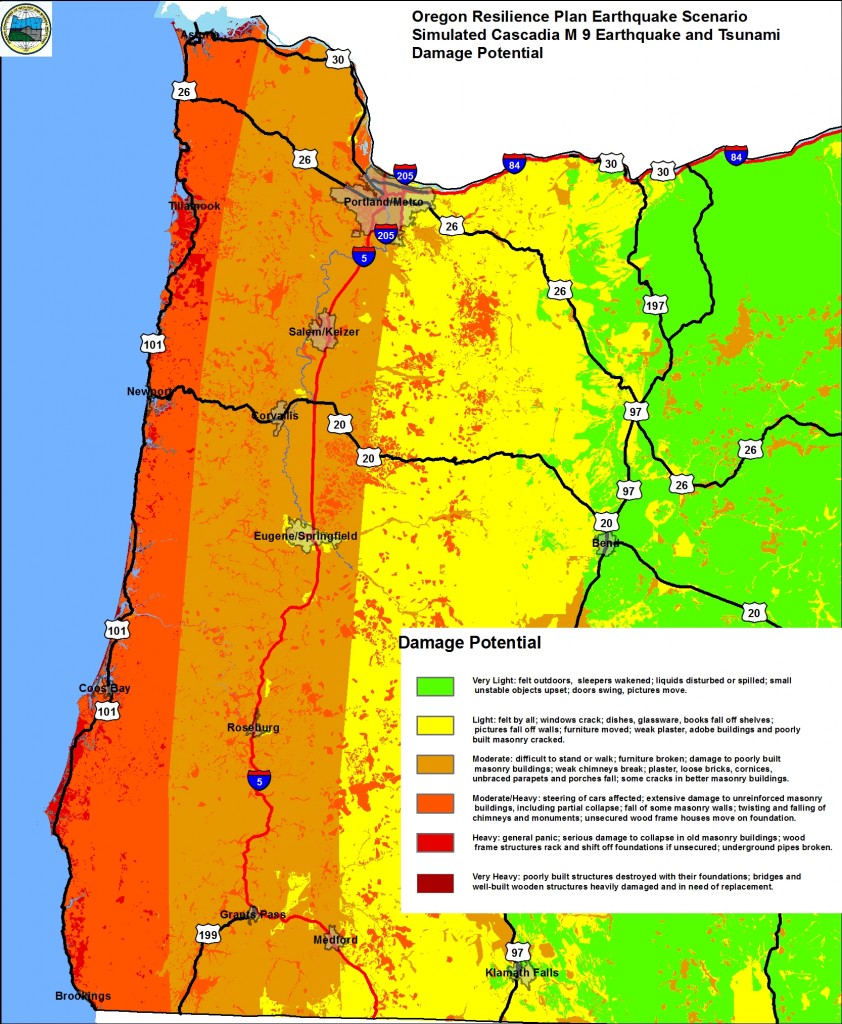June 2, 2014
The Challenges of Seismic Mitigation in Oregon: Where Science and Policy Meet
Posted by kcompton
By Jeff Rubin, Emergency Manager, Tualatin Valley Fire & Rescue, Tigard, OR
We’re justifiably concerned about terrorism, but natural hazards still generate far greater risk in terms of number of incidents, geographic spread, casualties, and economic impact. On the positive side, Mother Nature is not an adaptive opponent (Gaiaism notwithstanding), which means that our actions to reduce natural-hazard impact can actually yield useful results.
Earthquake Country has a distinctly different way of life relative to Hurricane and Tornado Alleys and the other regions tagged by a particular natural hazard. Damaging earthquakes are rare events: minimal annual occurrence probabilities and lack of credible warning in the interval between decades and minutes make for scientific and psychosocial challenges. That means that many so-called “best practices” (translation: someone’s idea that may have worked at some point) that do well on, say the US Gulf Coast (more common occurrences and generally ample warning opportunities), are not necessarily generalizable.

Damage potential map for magnitude 9 Cascadia Subduction Zone earthquake in Oregon. Credit: Oregon Resilience Plan
So how do we deal with potentially catastrophic events with a < 1% annual occurrence rate in a region that has few disasters of any kind and only become aware of its hazard within the past forty years, and thus is dominated by seismic susceptibility? That’s the reality of the Pacific Northwest (PNW), where even the popular concept of earthquakes, such as it is, is based on “California-style earthquakes” – quick, shallow, and back to what we were doing. The PNW seismic hazard certainly includes crustal earthquakes, but from British Columbia to northern California, our worst-case scenario is a major “unzipping” of the Cascadia Subduction Zone, complete with 4-5 minutes of shaking, extensive liquefaction, and catastrophic tsunamis: in short, the worst of Japan, Chile, and Christchurch earthquakes over the past four years.
Oregon’s response to the threat posed by infrequent, potentially catastrophic CSZ mega-quakes is to look to science and engineering – not for a magical solution, but for a foundation. Oregon is a large but mostly rural state, with most of the population concentrated to the west of the Cascades. There are few better places for wine or microbrews, but the state is still in catch-up mode for seismic resilience. That said, state law recognized the need to incorporate “scientific evidence that may include geologic field data and tsunami modeling” in 1995, placing restrictions on development and siting critical infrastructure in tsunami inundation zones (since refined).
The thrust of applied science and engineering has been more recent, however. The Oregon Resilience Plan (ORP), established by the Oregon Legislature and completed in February 2013, capped a yearlong process to “make recommendations on policy direction to protect lives and keep commerce flowing during and after a Cascadia (megathrust) earthquake and tsunami.” Recognizing that the state has limited resources, which meant that lifelines and critical structures would likely not be replaced in the short term, the ORP covered the next fifty years, focusing on renovation and new construction, as well as making realistic plans with existing infrastructure. Later that year, the Oregon legislature commissioned another one-year body, the Oregon Resilience Task Force, charged with developing a focused list of priorities to implement the ORP: the Task Force issues its final report in October 2014. Both the ORP and Task Force incorporate science and engineering: one of the ORP leaders was an engineer, and the Task Force is led by a civil engineer and a geologist.
In a resource-poor state, we know we’re not going to be plowing billions into resiliency up front, but if we can establish clear priorities with strong scientific underpinnings, and establish a “home” for seismic resilience, we may be able to make small steps larger.
Jeff Rubin is the Emergency Manager for Tualatin Valley Fire & Rescue, Oregon’s largest fire district. He worked on the 2013 Oregon Resilience Plan, and is Vice Chair of the Oregon Resilience Task Force. He chairs the Geological Society of America’s Geology and Public Policy Committee, and has served an extended term on the First Responder Resource Group, under the US Department of Homeland Security’s Science and Technology Directorate. Jeff has a BS in Geology & Geophysics from Yale University and an MA and PhD in Geological Sciences from the University of Texas at Austin, and will be speaking at the 2014 AGU Science Policy Conference in June.


[…] The Bridge: Connecting Science & Policy (AGU blog) – The Challenges of Seismic Mitigation in Oregon: Where Science and Policy Meet […]
[…] The Bridge: Connecting Science & Policy (AGU blog) – The Challenges of Seismic Mitigation in Oregon: Where Science and Policy Meet […]